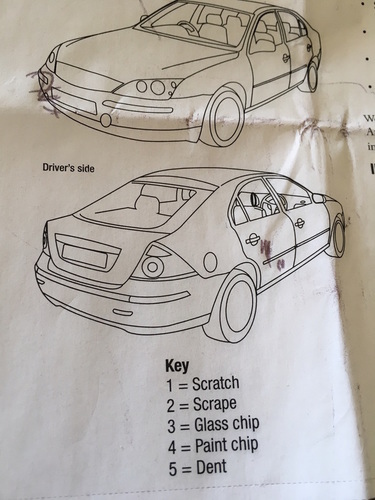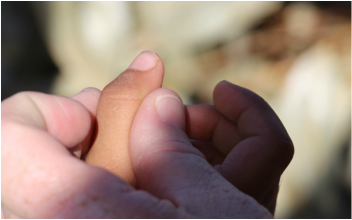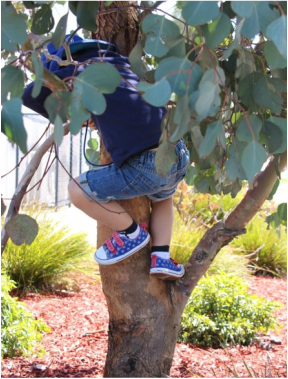|
http://www.naturallearning.net.au
Reporting on injuries to children while in careAs I walked around the rental car with my piece of paper comparing the sites of previous damage I suddenly had this brainwave!!!! We could create such forms for children - a little outline of a child, front and back of course, to document injuries! On arrival parents hand us the form with existing damage on their child clearly marked. At the end of the day we hand the child back with this form having marked any additional damage - the goal being not to add any further damage to the child! Parents check their child against the form and go home armed with this and of course a pile of accident forms completed in triplicate to account for every new mark. Brilliant I thought!!!! Far fetched? Not if we look at what is already happening! Could this be where we are heading? Already educators are filling in accident forms, often in duplicate or even triplicate, for every little mark, every scratch, bump or bruise. Some parents examine their child to look for any damage not accounted for by the educator so that somebody can be held accountable and the 'lack of supervision' can be questioned. Educators spend their days shouting ‘be careful’, ‘no climbing’, ‘ no running’, ‘no touching each other’, ‘keep hands to yourself’. Children are kept indoors because they can be 'controlled', it is seen as less risky than the outdoors. Should there be a new scratch, educators feel responsible, parents may be phoned at work, accident forms are completed and handed to the parent with an apology. "When we hand a parent an accident form, what are we actually ‘saying’? Learning injuries, common childhood injuries…..injuries that come with freedom and play, those grazed knees from running so very fast, we could sit and pick the scabs off? That magnificent bruise falling off the wall that you could boast about to your peers, even that broken arm you got when you fell off the monkey bars (you do need a form for this one!)? I spent my childhood envious of others with plaster casts, I wanted a broken arm too so my friends could draw on my white cast…..I wanted it so badly that I pretended to have a broken arm! I too wanted this 'badge of honour'. Common childhood injuries are evidence of a high quality childhood, not of neglect, negligence or lack of supervision! We spend far too much time focussing on physical injuries when the greatest majority of these are not serious or permanent. They are easily measured - how many accident forms filled in? How many band-aids dispensed? Lets look at the bigger picture of what actually constitutes real harm. What about the emotional harm we cause children by preventing them from having a childhood, the long term consequences of depriving children of the opportunity to make decisions, to take risks and face challenges….these are hard to see or measure but could have long term permanent consequences Nobody want to see children hurt, we have duty of care but we need to look beyond the physical. I am not advocating for additional tick lists recording emotional damage but lets look at the common sense approach to protecting and supporting children to be children. There is a place for accident forms but not a place for 'stupid' accident forms. Australian regulations require one for serious injuries where the child has reasonably needed medical treatment. This does not mean a cold compress or band aid was applied, this means the child needed to see a doctor, dentist, ambulance or hospital! Use professional judgement as to when an accident form should reasonably be completed. I would complete an accident form for: Do not apologise to families, you are following procedures, you did nothing wrong. Do not focus on the negative, share the positives with families. "you should have seen how well she problem solved climbing the tree! She does have a scratch on her face but she had such fun and was so proud of herself for achieving her goal"
In conclusion, nurture your parents, advocate for children, realise the benefits of having some accidents, do not apologise to parents and throw away those stupid accident forms! PS I never did break a bone!
19 Comments
Jean Kuhl
2/17/2016 12:31:12 am
Excellent information!
Reply
Barbara Easton
2/17/2016 06:21:34 am
Your pist hit home with me Niki. It is too much of reality already with liability in my area of Southern California. My thoughts start with exploring our vision, mission and goals then build the family and staff handbooks on expectations and the whys of optimal development through exploration the program provides. We can invite families into our program as partners in their children's learning.
Reply
Niki Buchan
2/19/2016 09:56:57 pm
I always like the concept of parents being partners. Sadly most of the documentation is done because educators fear parents and their reaction should something go wrong. That is not really a partnership. How sad that your 5 year old was not allowed to run in the playground, I hate to ask ...why???
Niki Buchan
2/19/2016 09:53:24 pm
Thank you Jean :-)
Reply
Very true! The minor accidents cannot be avoided, especially when working with toddlers. They don't have well developed balancing skills and often bump into things and fell over. They do not understand the concept of sharing yet, so they take toys from each other, accidently scratching with their often univenly cut nails:) And most of these accidents happen in a controlled and safe enviroment, not outside. Every accidents form written to document these only add to the stress of the educarer, child and parents, not to mention addicional work and paper waste:)
Reply
Niki
2/19/2016 10:00:30 pm
Accidents WILL happen and everybody needs to stop stressing. Imagine if parents started pursuing the parents who cut their child's uneven nails which then scratched their own child! As you mentioned, children and especially toddlers are made to fall...
Reply
2/18/2016 09:47:12 pm
Great points made - BUT... I promise parents to 'bash, bruise and batter' their children when they join us at 50 Dangerous Things Camp. The whole point is that children are actively encouraged to take risks all day and if they don't go home with at least the odd scratch or bruise then we've done a poor job of helping them reach their potential. *Obviously* we aren't out to properly damage the children, but parents sign their children up to our camp knowing that a) we encourage risky behaviour, b) we use real tools, c) we're all paediatric first aid trained and d) we help children learn how to take risks in a managed, developmental way. We're also oversubscribed, so we know that there is demand for this approach from children and parents alike.
Reply
Niki
2/19/2016 10:05:59 pm
Thats a relief...that you don't properly damage the children Julie! :-) Jokes aside, it would make working with children so much easier if parents and practitioners were always on the same page as far as risks and accidents are concerned. Tom Hobson in Seattle also promised his parents that children will come home every day dirty, tired and bloody!
Reply
Niki Buchan
2/19/2016 09:52:39 pm
Right Tim! I despair at the amount of documentation many educators feel they need to do to protect themselves. Common sense is rather uncommon now.
Reply
2/20/2016 09:03:32 am
This is a fantastic post Niki! I loved it so much that I wrote a supporting one on my own blog! Thank-you for challenging my way of thinking.
Reply
Niki
2/20/2016 09:46:46 am
Thank you Jess, I like to make people think :-)
Reply
Julie Rose
5/5/2021 12:48:29 pm
It saddens me that there are childcare centres that still make you fill out incidents forms for little scratching and bumps. And then question you on your supervision, what about the supervision of the children whilst you are filling out the forms. I have worked at a centre where we just let the parents know on pick up about little Johnny falling over and scrapping knee .
Reply
Niki
5/6/2021 05:20:36 pm
I agree, and very often this is because someone has questioned them and told them they have to because that is their interpretation of the regulations. So much fear based practice happening :-(
Reply
Lee Gane
5/8/2021 09:26:52 am
Excellent points as always.
Reply
Niki
5/8/2021 06:37:37 pm
I agree, as nurturers we avoid conflict and try to please. I believe that this is why so many educators are struggling with burnout at the moment. It takes confidence, knowledge and inner strength to stand up for what we know is right.
Reply
LMom
5/11/2023 09:12:15 am
What if a more than 15 cm long bleeding scratch on the face from another aggressive child might leave a scar permanently that no oral explanation, no phone call, and no incident report provided? should I lodge a complaint to the DET?
Reply
5/31/2023 03:53:39 am
If this were my own child, I would want to know if the other child had intentionally and maliciously injured my child and why. I would also look at the seriousness of the injury; is it a deep scratch, does it need medical attention such as stitches. If the scratch reasonably needs medical attention and there is no incident report I would speak to the owner/director/manager of the service and if not satisfied with the result contact DET.
Reply
Leave a Reply. |
AuthorNiki Buchan Archives
March 2022
Categories |



 RSS Feed
RSS Feed